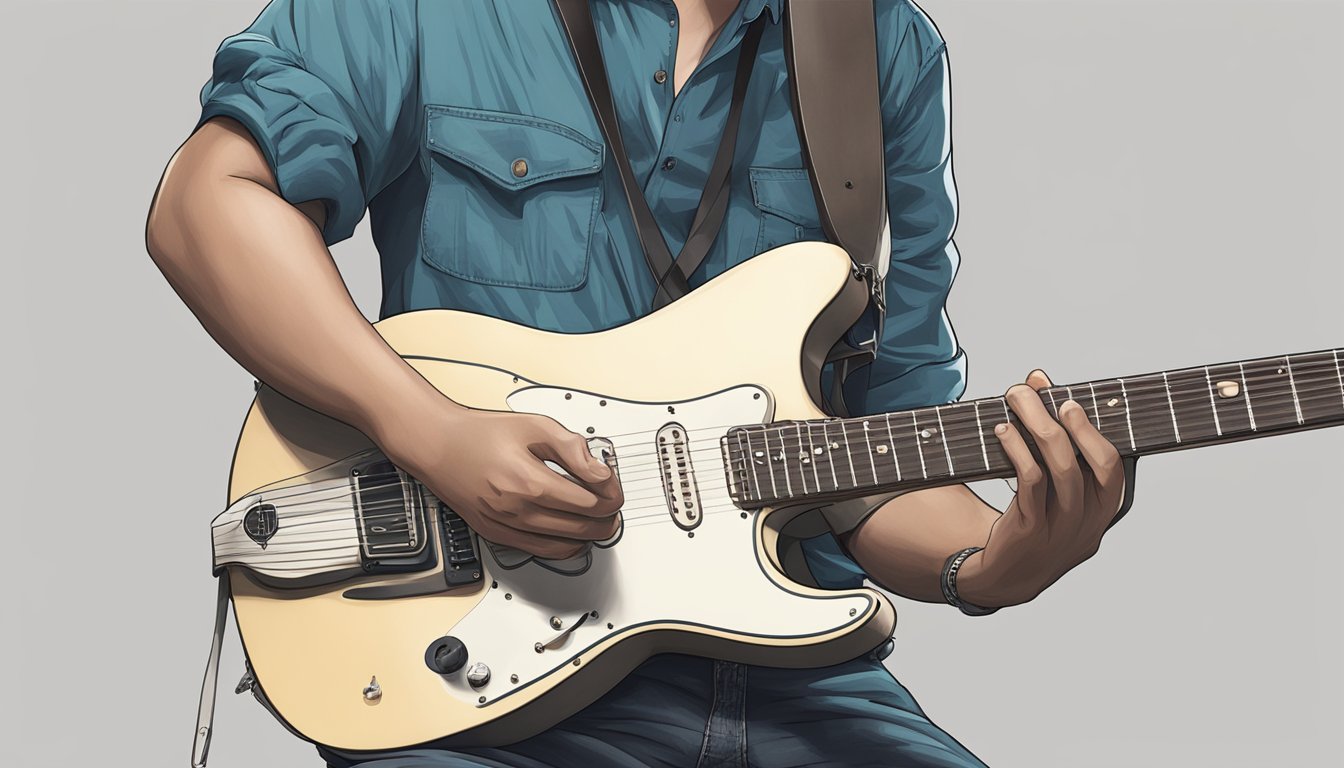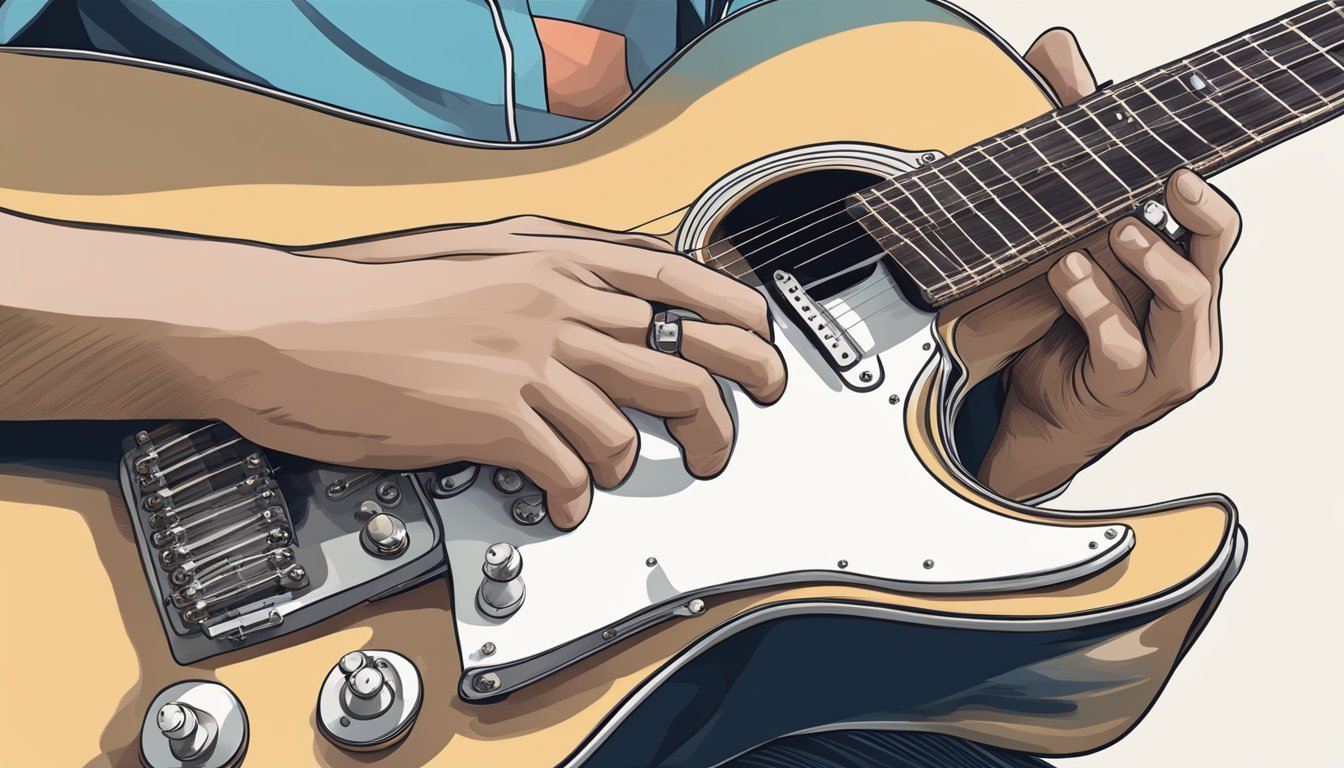Learning how to properly hold a right-handed guitar is essential to make music more enjoyable and easier for you.
Understanding the best way to position your guitar reduces strain on your hands and body while improving your playing skills.
Whether you’re sitting or standing, getting comfortable with your grip will help you play confidently.

As you find your ideal posture, you’ll also discover the importance of hand positioning.
Keeping your wrist relaxed and fingers agile lets you reach notes and chords more fluidly.
It’s not just about how you hold the instrument; it’s about how to make the most of your time playing.
Once you grasp the basics of holding your guitar, you’ll be ready to dive into making music.
With the right techniques in mind, you can enhance your practice sessions and enjoy playing even more.
Key Takeaways
- Holding your guitar correctly improves comfort and reduces strain.
- Proper hand positioning enhances your ability to play notes and chords.
- Understanding how to hold your guitar sets you up for a better playing experience.
Getting to Know Your Guitar

As you start your journey with guitar, it’s important to understand the different types available and how each part of the guitar works.
This knowledge will help you select the right instrument for your style and make playing easier.
Understanding Guitar Types
There are three main types of guitars: acoustic, electric, and classical.
Acoustic guitars use hollow bodies to amplify sound naturally.
They are great for strumming chords or fingerpicking.
Electric guitars, on the other hand, rely on electronic pickups to make sound.
They offer various tonal options and are often used in rock and pop music.
Classical guitars feature nylon strings and a wider neck, making them ideal for fingerstyle playing and classical music.
Choosing the right type of guitar depends on your musical taste and preferred playing style.
Anatomy of a Guitar
Knowing the parts of your guitar helps you play more effectively.
-
Fretboard: This is where your fingers go to create notes. The quality and material used can affect your playability.
-
Guitar Neck: The neck connects the body to the headstock. It should feel comfortable in your hand when playing.
-
Body: Each type of guitar has a different body shape, affecting sound and comfort.
-
Bridge: This is where the strings are anchored. It influences tuning stability and sound quality.
-
Headstock: Here you find the tuning pegs. Proper tuning is crucial for a good sound.
Understanding these parts will help you become a better player and make it easier to communicate with other musicians.
Fundamentals of Guitar Holding
Getting the right grip on your guitar is essential for comfort and technique.
The way you hold your guitar can affect your playing and overall performance.
Here’s what you need to know about posture and positioning, whether you’re sitting or standing.
Guitar Posture and Body Positioning
First, focus on your posture.
A straight back helps you play better and avoids fatigue.
Your shoulders should be relaxed, not hunched.
When positioning the guitar, keep it close to your body.
For a right-handed guitar, rest the body on your right leg if you’re sitting.
This allows easy access to the neck.
In the classical position, the guitar sits on your left leg with the neck raised higher.
Maintain a slight angle so you can see the fretboard clearly.
This way, your fingers can move without restriction, providing better access to the strings.
Holding the Guitar While Seated
When sitting, make sure to find a comfortable chair.
Avoid anything too low or soft, as it can make posture harder to maintain.
Sit with your back straight and your feet flat on the floor.
If you choose to use a guitar strap, it helps stabilize the guitar.
Just make sure it’s adjusted so the guitar sits at a height that feels natural for your arms.
You can rest the guitar body on your right thigh to keep it balanced.
If you go with the classical position, place the guitar on your left leg.
This might feel a bit different at first, but it provides good support and access to the fretboard.
Holding the Guitar While Standing
When you stand, a guitar strap is essential.
It keeps the guitar secure and at a comfortable height.
Adjust the strap so the guitar is about the same height as when you sit.
Your posture still matters.
Stand tall with your shoulders relaxed and your feet shoulder-width apart.
This keeps you steady and allows for better movement.
Just like when sitting, make sure the guitar is positioned snugly against your body.
Check that you can reach the neck easily.
Avoid holding the guitar too far forward or back, as this makes it hard to play.
Mastering Hand Positions
Getting your hand positions right can make a big difference in your guitar playing.
It’s all about how you hold the guitar and how your fingers move.
Here’s what you need to know.
The Fretting Hand
Your fretting hand, usually your left hand for right-handed players, is key for playing notes and chords.
Start by positioning your thumb in the middle of the back of the neck.
This provides support and allows for better finger movement.
When placing your fingers, use the tips to press down on the strings.
Keep your fingers curved and close to the fretboard.
This helps with clean notes and avoids buzzing sounds.
Try to avoid flat fingers as this can mute adjacent strings.
Finger placement is essential.
Use your index finger for the first fret, middle for the second, and so on.
This setup allows for quick shifts between chords.
Remember, practice will make your movements more natural.
The Strumming Hand
Your strumming hand, or your right hand, plays a crucial role in creating rhythm.
When holding the pick, grip it firmly between your thumb and index finger, letting it protrude slightly for better control.
Position your hand comfortably above the strings.
When strumming, try to keep your wrist relaxed and use a fluid motion.
This helps in achieving smooth strokes, whether you’re playing downstrokes or upstrokes.
If you feel stiff, shake out your hand.
A loose wrist will help you play with more fluidity.
Experiment with different picking techniques to find what feels best for you, whether it’s alternate picking or fingerpicking.
Frequently Asked Questions
There are many common questions when it comes to holding a right-handed guitar.
Here’s some helpful information to guide you through the basics.
What’s the best way for a newbie to hold a right-handed guitar?
For beginners, start by keeping the guitar close to your body.
Make sure the neck is angled slightly upwards.
Your left hand should be on the neck, while your right hand rests over the soundhole or pickups, depending on the type of guitar.
As you get comfortable with your grip, pay attention to your posture to ensure you’re not straining your back or arms.
Practicing regularly will also help you find the most natural position for your body and hands.
If you’re unsure about how to improve guitar holding, consider watching instructional videos or seeking advice from experienced players to refine your technique.
Can lefties easily play on right-handed guitars, or is it a struggle?
Lefties can play right-handed guitars, but it may feel awkward at first.
Some left-handed players choose to learn on a right-handed guitar to make it easier to find one.
It just takes some time to get used to the positioning.
What’s the proper way to grip a guitar pick when strumming?
Hold the pick between your thumb and the first finger.
Make sure it’s held loosely—too tight can create tension in your hand.
The pointed end of the pick should extend out for easy strumming.
Are there specific tips for holding chords comfortably on a right-handed guitar?
When holding chords, ensure your fingers are arched so the tips press the strings evenly.
It helps to keep your wrist straight.
This positioning gives you better control and makes it easier to switch between chords.
Should an electric guitar be held differently than an acoustic for right-handers?
Generally, the hold is similar for both electric and acoustic guitars.
However, with an electric guitar, you might adjust your right arm to accommodate the difference in body shape.
Make sure your grip is relaxed for both types.
Is there really a wrong way to hold a guitar, or does it just come down to whatever feels good?
Some basic guidelines exist, but comfort is key.
Everyone has their style, and what works for you might not work for someone else.
So, focus on holding your guitar in a way that feels natural to you.

